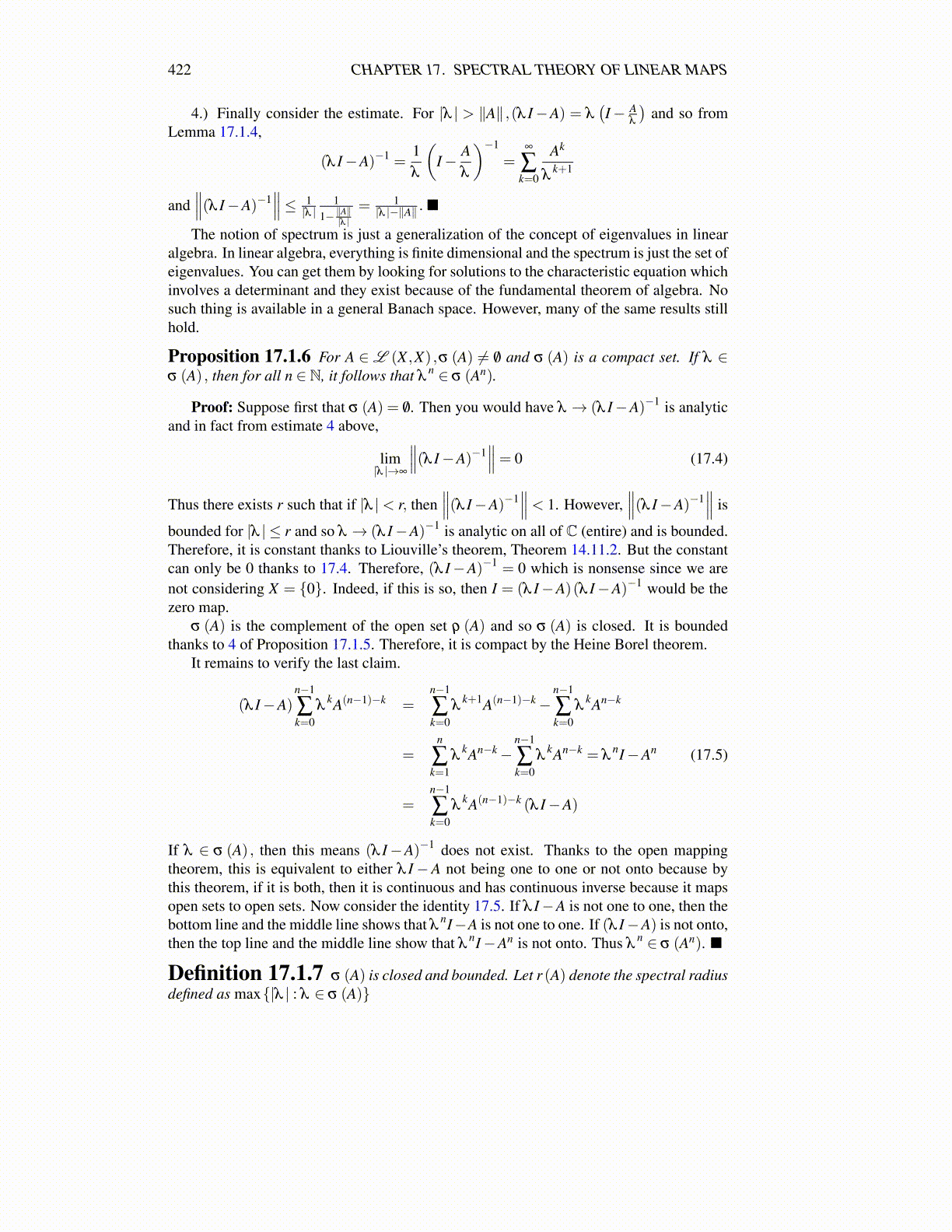
422 CHAPTER 17. SPECTRAL THEORY OF LINEAR MAPS
4.) Finally consider the estimate. For |λ | > ∥A∥ ,(λ I−A) = λ(I− A
λ
)and so from
Lemma 17.1.4,
(λ I−A)−1 =1λ
(I− A
λ
)−1
=∞
∑k=0
Ak
λk+1
and∥∥∥(λ I−A)−1
∥∥∥≤ 1|λ |
11− ∥A∥|λ |
= 1|λ |−∥A∥ .■
The notion of spectrum is just a generalization of the concept of eigenvalues in linearalgebra. In linear algebra, everything is finite dimensional and the spectrum is just the set ofeigenvalues. You can get them by looking for solutions to the characteristic equation whichinvolves a determinant and they exist because of the fundamental theorem of algebra. Nosuch thing is available in a general Banach space. However, many of the same results stillhold.
Proposition 17.1.6 For A ∈ L (X ,X) ,σ (A) ̸= /0 and σ (A) is a compact set. If λ ∈σ (A) , then for all n ∈ N, it follows that λ
n ∈ σ (An).
Proof: Suppose first that σ (A) = /0. Then you would have λ → (λ I−A)−1 is analyticand in fact from estimate 4 above,
lim|λ |→∞
∥∥∥(λ I−A)−1∥∥∥= 0 (17.4)
Thus there exists r such that if |λ |< r, then∥∥∥(λ I−A)−1
∥∥∥< 1. However,∥∥∥(λ I−A)−1
∥∥∥ is
bounded for |λ | ≤ r and so λ → (λ I−A)−1 is analytic on all of C (entire) and is bounded.Therefore, it is constant thanks to Liouville’s theorem, Theorem 14.11.2. But the constantcan only be 0 thanks to 17.4. Therefore, (λ I−A)−1 = 0 which is nonsense since we arenot considering X = {0}. Indeed, if this is so, then I = (λ I−A)(λ I−A)−1 would be thezero map.
σ (A) is the complement of the open set ρ (A) and so σ (A) is closed. It is boundedthanks to 4 of Proposition 17.1.5. Therefore, it is compact by the Heine Borel theorem.
It remains to verify the last claim.
(λ I−A)n−1
∑k=0
λkA(n−1)−k =
n−1
∑k=0
λk+1A(n−1)−k−
n−1
∑k=0
λkAn−k
=n
∑k=1
λkAn−k−
n−1
∑k=0
λkAn−k = λ
nI−An (17.5)
=n−1
∑k=0
λkA(n−1)−k (λ I−A)
If λ ∈ σ (A) , then this means (λ I−A)−1 does not exist. Thanks to the open mappingtheorem, this is equivalent to either λ I−A not being one to one or not onto because bythis theorem, if it is both, then it is continuous and has continuous inverse because it mapsopen sets to open sets. Now consider the identity 17.5. If λ I−A is not one to one, then thebottom line and the middle line shows that λ
nI−A is not one to one. If (λ I−A) is not onto,then the top line and the middle line show that λ
nI−An is not onto. Thus λn ∈ σ (An). ■
Definition 17.1.7 σ (A) is closed and bounded. Let r (A) denote the spectral radiusdefined as max{|λ | : λ ∈ σ (A)}